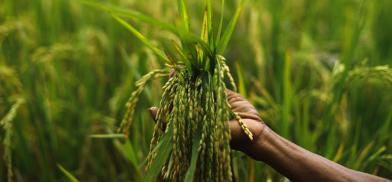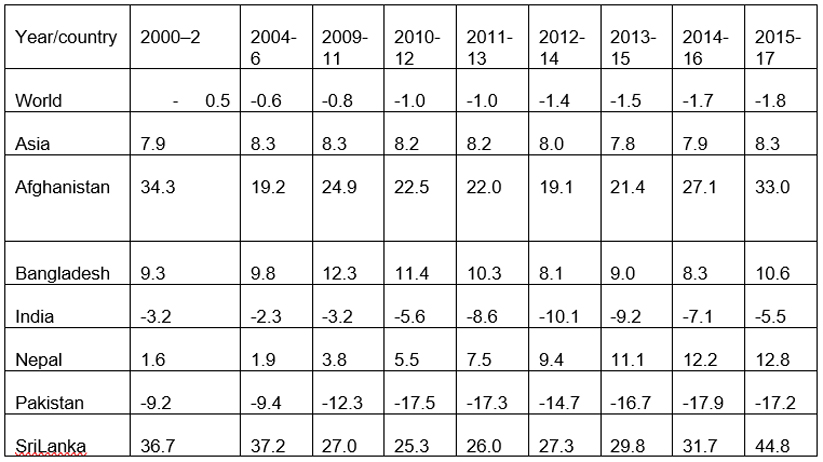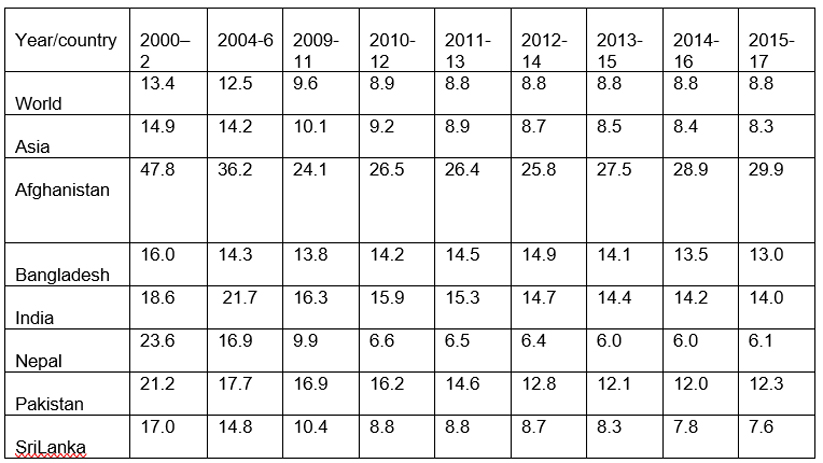South Asian countries need to strengthen regional cooperation in food security, agriculture systems
COVID-19 has brought into focus supply chain issues and with it a fundamental change in the way food availability and access is viewed, one that goes beyond the conventional focus on weather, area, production, and yield (APY) paradigm of crops, writes Partha Pratim Mitra for South Asia Monitor

A joint study by the World Food Programme (WFP) and the International Organization for Migration (IOM) goes into the linkages between food security and mobility. The economies in South and Southeast Asia are characterized by high levels of informal labour, export orientation, and dependence on remittances. This leaves them extremely exposed to the global economic disruption caused by the COVID-19 pandemic.
Key sectors such as the textile industry have been heavily disrupted by the pandemic and countries with widespread informal employment have been struggling to provide residents with social protection. The annual outflow of migrants from South and Southeast Asian countries stood at 58.4 million at the end of 2019. Around 21.8 million (37 percent) migrated towards the Gulf Cooperation Council (GCC) Member States, while 17.1 million (29 percent) migrated within the region; the remainder went to other regions. The countries of origin of the largest numbers of migrants in 2019 were India (17.5 million), Bangladesh (7.8 million) and Pakistan (6.5 million).
Dependence on remittances
While for countries such as India and Bangladesh, reliance on remittances has fallen steadily over the past two decades along with their rapid economic growth, the region continues to receive substantial remittance inflows. Nepal was among the countries most reliant on receiving remittances in 2019, with an inflow of USD 8 billion, representing 27 percent of GDP. Migration can be an important strategy used by households to cope with income uncertainties and resultant food insecurity risks. Poor rural households often send one or more family members into cities or to other countries for work to mitigate the crisis of extreme poverty and hunger. Generally, households which receive remittances tend to have better food security outcomes than those without this income source.
The global COVID-19 pandemic has affected these established livelihoods and risk management mechanisms of the common people. Remittances help many households diversify their income and meet their food and other essential needs. Drying up remittances due to the pandemic could hamper the food security of households, nutrition, health, and educational attainment of children as it reduces their financial capability to access these necessities.
Income uncertainties would also make households settle for low-quality diets and might have also forced to reduce the quantity of food they would normally eat because of a lack of money or other resources. It is an indicator of a lack of food access and increased food insecurity.
An important way to depict food insecurity is to look at the food net- trade, defined as the nominal value of exports minus that of imports and a measure of food security is the cereals imports dependency ratio, defined as the net trade of cereals (imports minus exports) divided by the total cereals supply in a country (the country’s own production plus the imports minus the exports).
Table 1: Cereals Import Dependency Ratio (per cent)

Note: Data for Bhutan and Maldives was not given.
Source: World Food and Agriculture - Statistical Yearbook 2020
The cereal import dependency ratio provides a measure of the dependence of a country or region on cereal imports. The higher the value of the indicator the higher is the dependence. Specifically, the cereal imports dependency ratio tells how much of the available domestic food supply of cereals has been imported and how much comes from the country’s own production. It is computed as (cereal imports - cereal exports)/ (cereal production + cereal imports - cereal exports) * 100. Given this formula, the indicator assumes only values less than or equal to 100. Negative values indicate that the country is a net exporter of cereals. The indicator is calculated in three-year averages, to reduce the impact of possible errors in estimated production and trade, due to the difficulties in properly accounting for stock variations in major foods.
While the world is a net exporter of cereals, Asia is not including many South Asian countries. The countries which are food insecure by the criteria of food net- show a greater imbalance in their primary crop production consisting of cereals, sugar crops, vegetables, oil cakes, fruits, roots and tubers and other crops. These countries have a larger share of cereals in their primary crop production than the other countries. Sri Lanka, Afghanistan, Nepal and Bangladesh, the four countries relatively are more food insecure than either India or Pakistan (See Table 1) has for the year 2018 a much higher share of cereals in their total primary crop production as compared to the other two countries.
The share of cereals in primary crop production as estimated from the FAO statistics for 2018 are:
Sri Lanka - 36.8 percent,
Afghanistan - 51.4 percent,
Bangladesh-68.5 percent,
Nepal - 42.9 percent,
India -29.6 percent and
Pakistan - 31.7 percent.
The trends show that food-insecure countries have concentrated more on producing cereals and have not been able to ensure a more diversified primary crop production.
Another way of looking at food insecurity is to see the Prevalence of Undernourishment (PoU) in the population. It is a statistical estimate which gives the percentage of the population whose consumption falls below what is known as the Minimum Dietary Energy Requirement (MDER). It is the minimum amount of energy required through food intake for the population to be in good health and maintain a level of activity that enables the individual to maintain living standards that are socially acceptable. PoU gives a quantitative assessment of the macro-level food access trends and, given its widespread use in the past five decades, is useful in identifying national and global trends in population-level undernourishment.
The PoU is calculated as the percentage of the population whose consumption falls below the MDER and is a measure of undernourishment caused by a food deficit.
Table 2: Prevalence of undernourishment in the population (percent)

Note: Data for Bhutan and Maldives not given
Source: World Food and Agriculture - Statistical Yearbook 2020
The data on undernourishment shows that although Asia is better as compared to world figures, for some countries, the situation is quite above the world and the Asian figures (See table 2). While all countries have shown improvement over the years, the improvement has plateaued in most countries of the region in recent years, while in Afghanistan it has deteriorated with the prevalence of undernourishment in the population going up for that country.
COVID-19 impact on food availability
Sri Lanka and Bangladesh have shown more improvement as compared to the other countries in the region between 2012-14 and 20151-7, despite their food insecurity as measured by the net-food trade criteria. An important reason could be better food access in these countries. The COVID-19 pandemic is expected to increase the risk of all forms of malnutrition.
COVID-19 has brought into focus supply chain issues and with it a fundamental change in the way food availability and access is viewed, one that goes beyond the conventional focus on weather, area, production, and yield (APY) paradigm of crops. Sustaining livelihoods, in which the role of labour, particularly of migrants and casual labour, along with working capital to set up sustainable supply chains and of services like cold storage and warehouse systems have emerged as crucial determinants of food security.
The COVID-19 crisis provides an opportunity for South Asian countries to strengthen regional cooperation in areas related to food security and agriculture systems by building resilience to climate change, regional trade liberalization in agriculture to ensure price and supply stability and operationalization of food and seed banks can provide food reserves and buffers against unexpected supply shocks.
Intra-regional cooperation seems to be the only option to resolve all issues and needs to be explored more seriously.
(The writer is a retired Indian Economic Service officer who worked in the labour ministry. Views expressed are personal. He can be contacted at ppmitra56@gmail.com)
References:
Populations at risk: Implications of COVID-19 for hunger, migration and
displacementhttps://docs.wfp.org/api/documents/WFP-
0000120687/download/?_ga=2.164784572.2087035715.1605094069-1580816180.1603198765p38-
39,November 2020
2 Required citation: FAO. 2020. World Food and Agriculture - Statistical Yearbook 2020. RomeP50-51.
https://doi.org/10.4060/cb1329enhttp://www.fao.org/3/cb1329en/CB1329EN.pdf
3 Ibid ,p19
4 https://inddex.nutrition.tufts.edu/data4diets/indicator/prevalence-undernourishment
knowledge.









Post a Comment